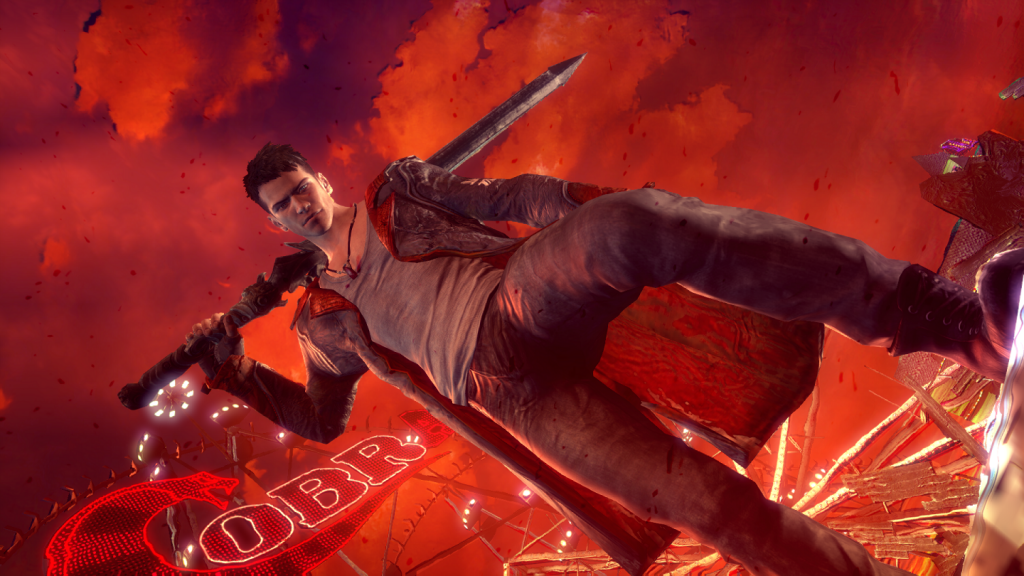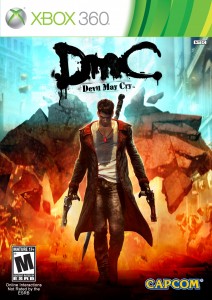 BUY IT FROM AMAZON: RIGHT HERE!
BUY IT FROM AMAZON: RIGHT HERE!
PLATFORM: XBox 360 (reviewed), PS3, PC
PRICE: $59.99
ESRB RATING: M
DEVELOPER: Ninja Theory
PUBLISHER: Capcom
The oddest reaction I’ve had, after spending upwards of 12 hours with the new Devil May Cry, is that it makes me really worry about Japan. It’s bad enough that JRPGs have been steadily declining in quality the last couple of years compared to their gaijin counterparts, it starts to raise some question marks when the best Japanese action titles of the last few years have all either been farmed out to Western developers (Metroid Prime, Castlevania: Lords of Shadow), or been developed with Western sensibilities in mind (Ninja Gaiden II, Bayonetta, anything with Suda 51’s name on it). Seeing as the new Ninja Theory-developed Devil May Cry is by far the best game in the series, if I were a Japanese developer, I’d be having quite the moment of clarity.
Devil May Cry (and, I’m sorry, guys, but unless Dante starts telling sucker MCs to call him sire any time in the near future, we’re leaving the DmC out of it from here) is all at once the sum total of the games that came before, and their complete dismantling. Taking the series’ rock n’ roll sensibilities into account, the first 4 games are Screaming For Vengeance, 1984, Appetite For Destruction, and Slippery When Wet. Ninja Theory’s game is Nevermind. From the first stage, it’s immediately familiar as a Devil May Cry game and yet, within 5 minutes of looking around at the world, and the options available to the player to dispatch your enemies, whatever came before seems kinda quaint and kitschy.
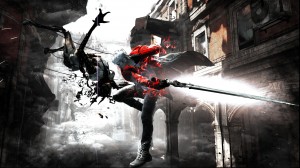 The Western sensibility mentioned before helps. The world of the new Devil May Cry is less the typical Paradise Lost riffs mingling with hair metal posturing of the past than a modern day punk rock/industrial blasphemy, and it’s not the window dressing to the game so much as its lifeblood. The score is no longer ominous choirs and bells interspersed with random industrial buttrock, but haunting, brutal dubstep overtones, and hardcore shredding courtesy of industrial acts Combichrist and Noisia. Dante’s magical glyphs are laid down with graffiti. Vergil is less a smirking evil anime twin than a Morpheus to Dante’s Neo. The one truly great boss fight in the game is with the holographic head of ersatz Bill O’Reilly, literally being attacked by the No-Spin Zone on two channels. Series Big Bad Mundus is now a soft-spoken Wall Street Thanos, with a surgical addict for a fuck buddy. His evil plot is more of the “greatest trick the devil ever pulled” variety, lulling the populace to sleep via their opiates of choice. One of the best bits of storytelling in the game is Vergil taking Dante to a park in the middle of the city, and the entire backstory of the twins is being told in the graffiti murals as they walk past. It isn’t Faust by any means, and its got that Arkham City problem where all the women are called bitches and whores with no answer from the ladies in question to fight that assertion, but it is still far smarter and even more subtle than a game where a demon attack forces the hero to get dressed after last night’s threesome in bullet time would suggest. Devil May Cry finally feels up to date, in look, feel, and most certainly in attitude, something the past games always shoved down our throats, something that this one does far more organically.
The Western sensibility mentioned before helps. The world of the new Devil May Cry is less the typical Paradise Lost riffs mingling with hair metal posturing of the past than a modern day punk rock/industrial blasphemy, and it’s not the window dressing to the game so much as its lifeblood. The score is no longer ominous choirs and bells interspersed with random industrial buttrock, but haunting, brutal dubstep overtones, and hardcore shredding courtesy of industrial acts Combichrist and Noisia. Dante’s magical glyphs are laid down with graffiti. Vergil is less a smirking evil anime twin than a Morpheus to Dante’s Neo. The one truly great boss fight in the game is with the holographic head of ersatz Bill O’Reilly, literally being attacked by the No-Spin Zone on two channels. Series Big Bad Mundus is now a soft-spoken Wall Street Thanos, with a surgical addict for a fuck buddy. His evil plot is more of the “greatest trick the devil ever pulled” variety, lulling the populace to sleep via their opiates of choice. One of the best bits of storytelling in the game is Vergil taking Dante to a park in the middle of the city, and the entire backstory of the twins is being told in the graffiti murals as they walk past. It isn’t Faust by any means, and its got that Arkham City problem where all the women are called bitches and whores with no answer from the ladies in question to fight that assertion, but it is still far smarter and even more subtle than a game where a demon attack forces the hero to get dressed after last night’s threesome in bullet time would suggest. Devil May Cry finally feels up to date, in look, feel, and most certainly in attitude, something the past games always shoved down our throats, something that this one does far more organically.
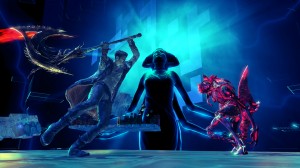 The game doesn’t throw the baby out with the bathwater. It’s still about a brash young demon slayer in a red coat with a giant sword who sets out to save the world from Big Evil. The series’ gothic aesthetic is still slyly present. Killing with style is still rewarded well. Dante himself is still kind of a twa–
The game doesn’t throw the baby out with the bathwater. It’s still about a brash young demon slayer in a red coat with a giant sword who sets out to save the world from Big Evil. The series’ gothic aesthetic is still slyly present. Killing with style is still rewarded well. Dante himself is still kind of a twa–
Actually, NO. Thanks to Alex Garland’s script–yes, they roped THAT Alex Garland into writing a Devil May Cry game–I am proud to say that Dante has now earned himself an upgrade to the status of Asshole. He’s still the kind of guy you’d run into in a bar who’d likely spend the night trying and possibly succeeding to fuck your girl in the men’s room handicap stall because he says he’s in a band, but despite some truly unfortunate emo hair, Dante actually borders on likeable here. It helps that Garland’s come up with some great profane one-liners for him on this go around, but more importantly, once the weight of his abilities starts to hit home, he gets his shit together, and decides to kick ass for the Lord. His dickishness is focused on flipping off evil, where it belongs, and Garland is smart enough to recognize, in a much less cartoony way than Devil May Cry 3 did it, that this character works if he actually rises above the young/dumb/full o’ demon come persona we see in the game’s intro. Yes, good people, Dante actually has a character arc. He actually forges a meaningful, non-sexual relationship with his girl sidekick, takes personal accountability for his fuckups, and actually develops a snarky, grudging respect and fratboy comeraderie with brother Vergil. Spending 8-10 hours with this Dante is far less of a chore. That by itself, after three games of a preening, unrepentant platinum-haired tit for a protagonist, is a miracle.
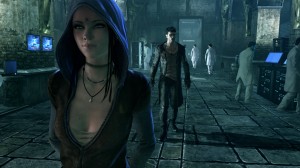 It’s particularly fortunate we have a better Dante since this is a brilliantly realized world Ninja Theory have crafted for him to run around in. Where the prior games stuck pretty closely to the gothic castle and unearthly desolate landscapes, this game has more in common with Constantine‘s urban ruin version of Hell than anything. Everything seems stuck in a perpetual sandstorm when the demons come to play. Invisible walls are less the transparent red demons of the past, more Inception-y frozen explosions. The coming of the demons or new obstacles are now heralded by They Live-style subliminal messages. Where the game surpasses those influences is in the level design, which really doesn’t have a comparison. Ninja Theory’s excelled at this before, especially with the Life After People urban forest of Enslaved. They’ve raised their game here. You’ll be taken through everything from wild, inside-out, spiraling cityscape to what can only be described as Tron In Hell, and everything in between. The game kicks Unreal Engine in the ass, taking full advantage of every square foot of sprawling real estate when it can, turning levels all around the player at all times, and the grappling mechanics for swinging around are the culmination of everything God of War, Bionic Commando, et al were trying to get at.
It’s particularly fortunate we have a better Dante since this is a brilliantly realized world Ninja Theory have crafted for him to run around in. Where the prior games stuck pretty closely to the gothic castle and unearthly desolate landscapes, this game has more in common with Constantine‘s urban ruin version of Hell than anything. Everything seems stuck in a perpetual sandstorm when the demons come to play. Invisible walls are less the transparent red demons of the past, more Inception-y frozen explosions. The coming of the demons or new obstacles are now heralded by They Live-style subliminal messages. Where the game surpasses those influences is in the level design, which really doesn’t have a comparison. Ninja Theory’s excelled at this before, especially with the Life After People urban forest of Enslaved. They’ve raised their game here. You’ll be taken through everything from wild, inside-out, spiraling cityscape to what can only be described as Tron In Hell, and everything in between. The game kicks Unreal Engine in the ass, taking full advantage of every square foot of sprawling real estate when it can, turning levels all around the player at all times, and the grappling mechanics for swinging around are the culmination of everything God of War, Bionic Commando, et al were trying to get at.
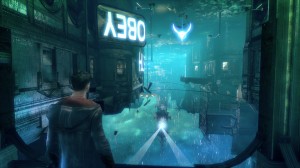 This would all mean nothing if Ninja Theory hadn’t delivered on the gameplay though. And there is no debate here that they did. Combat is the sum total of all lessons learned through course of the series, and switching from sword to scythe to axe to fists to pistols to shotguns at the single push of a button has never been smoother or more satisfying, and that’s not even counting aerial combat. Getting SSS ranks in fights always felt like an impossible dream before. Now, it’s a simple matter of creativity. To get the correct dance of death to achieve the highest ranks is to compose a near literal symphony of destruction, using all the tools at your disposal at just the perfect time. The enemies make it easy for you early on, but even on the easiest difficulties, the game still paces itself nicely, building on a slow escalation of the player’s skillset. It kinda has to, to be fair–the game is the first to embrace the sad inevitability that is the instruction manual going the way of the dinosaur–but the placement and ramping here is still very deliberate on Ninja Theory’s part, and pushes just hard enough to be satisfying till you inch up the difficulty to Son of Sparda and beyond, where everything is just bottled unforgiving insanity. And yet even then, there is not a single obstacle or enemy that the game does not give you the tools to handle and look like a boss doing it. It’s the perfect balance between shit-eating grin inducing ease and foot-to-ass punishment, and its good enough to want to start the game over the second that final stage achievement triggers.
This would all mean nothing if Ninja Theory hadn’t delivered on the gameplay though. And there is no debate here that they did. Combat is the sum total of all lessons learned through course of the series, and switching from sword to scythe to axe to fists to pistols to shotguns at the single push of a button has never been smoother or more satisfying, and that’s not even counting aerial combat. Getting SSS ranks in fights always felt like an impossible dream before. Now, it’s a simple matter of creativity. To get the correct dance of death to achieve the highest ranks is to compose a near literal symphony of destruction, using all the tools at your disposal at just the perfect time. The enemies make it easy for you early on, but even on the easiest difficulties, the game still paces itself nicely, building on a slow escalation of the player’s skillset. It kinda has to, to be fair–the game is the first to embrace the sad inevitability that is the instruction manual going the way of the dinosaur–but the placement and ramping here is still very deliberate on Ninja Theory’s part, and pushes just hard enough to be satisfying till you inch up the difficulty to Son of Sparda and beyond, where everything is just bottled unforgiving insanity. And yet even then, there is not a single obstacle or enemy that the game does not give you the tools to handle and look like a boss doing it. It’s the perfect balance between shit-eating grin inducing ease and foot-to-ass punishment, and its good enough to want to start the game over the second that final stage achievement triggers.
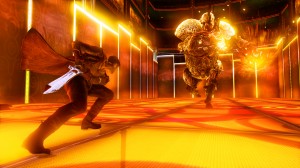 This all adds up to the kind of that makes the industry’s manifest destiny about getting the next gen out there within the next year or so all the more contemptuous. The next level of gaming is happening right now, no new hardware required. 2001’s Devil May Cry was a grand statement of purpose by Capcom, showing the gaming world that the Playstation 2 wasn’t just a DVD player. 12 years later, on the other end of the spectrum, 2013’s Devil May Cry is a snarling, swaggering, bass-dropping middle finger of a game showing that the 360/PS3 generation of gaming isn’t dead yet. Dante is back. And the son of Sparda has never looked, sounded, or played better.
This all adds up to the kind of that makes the industry’s manifest destiny about getting the next gen out there within the next year or so all the more contemptuous. The next level of gaming is happening right now, no new hardware required. 2001’s Devil May Cry was a grand statement of purpose by Capcom, showing the gaming world that the Playstation 2 wasn’t just a DVD player. 12 years later, on the other end of the spectrum, 2013’s Devil May Cry is a snarling, swaggering, bass-dropping middle finger of a game showing that the 360/PS3 generation of gaming isn’t dead yet. Dante is back. And the son of Sparda has never looked, sounded, or played better.
…still needs a haircut, though. Damn kids.
Rating:





out of 5
